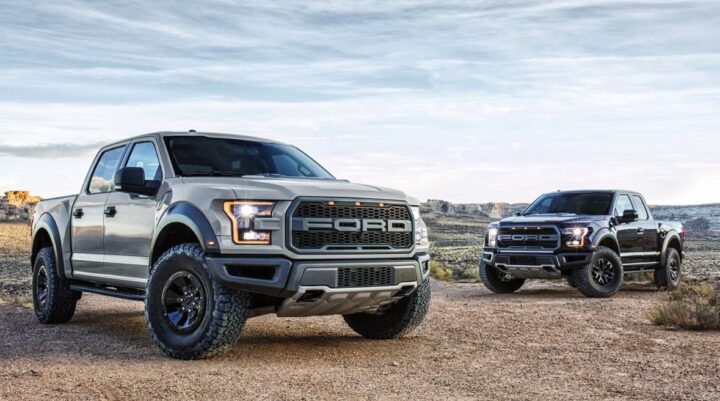
- Most of the used Ford F-150 models are great options
- Sources declare 2012 the worst model year because of engine problems
- Transmission issues is one of the most common Ford F-150 reliability issues for 2011, 2012, 2018, and 2019 model years
Related Articles
Toyota Tundra Reliability
Toyota With 200k Miles
Dodge RAM 1500 Reliability
Easiest Truck To Work On Myself
The Ford F150 has been one of the most popular used trucks over the last 40 years. And it was a very strong competitor to the Chevy Silverado, Toyota Tundra, and Ram 1500 models. The ninth-generation Ford F-150 arrived in 2021. But let’s take a look at the past generations of this legendary truck. Then I’ll break down the Ford F-150 reliability by year.
If you are searching for a good used truck, most of the used Ford F-150 models are great options. In general, they are a reliable choice. The F-150 models last around 100,000 to 250,000 miles. Averaging 15,000 miles per year this is equal to last about 17 years with proper care and maintenance. The Ford F-150 models provide the best value for money. Also to it suits most of the driver’s needs.
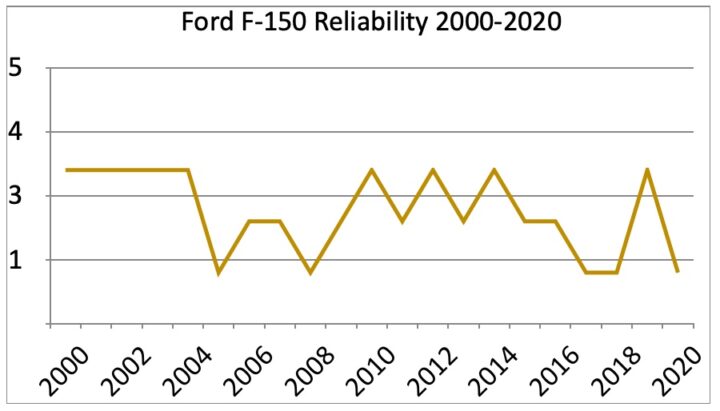
Table of Contents
Ford F-150 Manufacturing Generations
1975 – 1979 Ford F-150 (1st Generation)
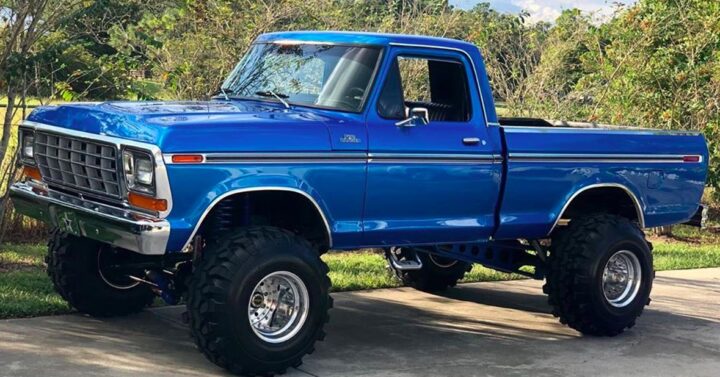
Ford introduced the F-150 in 1975. The seven generations of the Ford F-Series include the F-100, F-150, F-250, and bigger. Ford also offers regular and super cab options.
1980 – 1986 Ford F-150 (2nd Generation)
The 2nd generation of the Ford F-150 was introduced in 1980 with an equivalent wheelbase and cargo capacity of the first generation, yet with less weight. with the second iteration of the F-150, Ford improved its styling and offered regular and super cab options.
1987 – 1991 Ford F-150 (3rd Generation)
Beginning in 1987 the F-150 saw a rather more rounded design than the previous generation F-150. While engine options remained the same with additional horsepower gains. Smart engineering Ford. The four-speed manual transmission became standard with the four-speed automatic being an upgrade. Further improvements in ride dynamics made the F-150 a comfortable daily driver and a reliable family vehicle.
1992 – 1996 Ford F-150 (4th Generation)
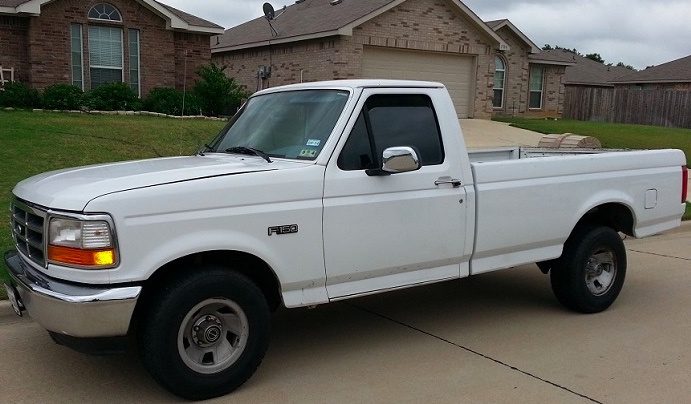
The Ford F-150 4th generation was introduced in 1992 with more aerodynamic styling and a choice of a base inline six-cylinder or an equivalent V8 engine options, respectively, 5.0-liter and 5.8-liter engines. These were linked with a three-speed automatic, four-speed manual, four-speed automatic, and even a five-speed manual transmission.
1997 – 2003 Ford F-150 (5th Generation)
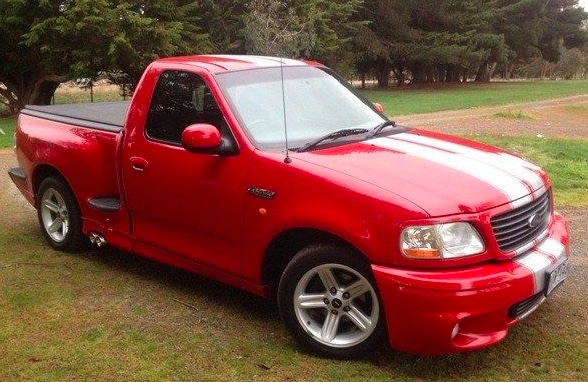
1997 saw a whole makeover of the F-150 design with both regular and super cab layouts. It had been more rounded and more oriented to being a passenger vehicle and especially as a dependable work vehicle.
The inline six-cylinder was changed to a 4.2-liter V6. The V8 options were replaced with 4.6 and 5.4-liter units, which produced over 200 horsepower. The five-speed manual transmission remained standard transmission.
2004 – 2008 Ford F-150 (6th Generation)

The sixth generation starting in the 2004 model year presented an exterior redesign that featured a more classic squared design within the headlights and other design elements that were resembled its original model stylings than the fifth generation.
Both the regular cab and super crew featured four doors while interior comfort improved to a high level, making the F-150 larger and more suitable for the family than the previous models.
Ford kept its reliable V6 with a five-speed manual standard. The 5.4-liter V8 remained optional, and it had been only available in an automatic transmission in the higher-end models.
2009 – 2014 Ford F-150 (7th Generation)
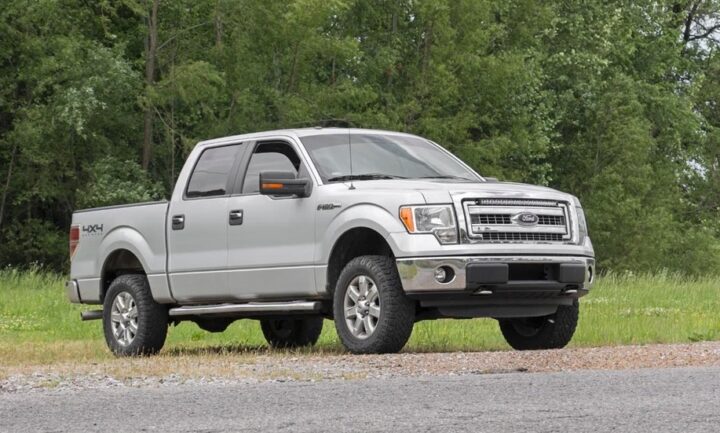
2009 model presented a complete redesign of the F-150, including a fully boxed frame and luxury features that were previously reserved for only luxury SUVs. All-new engine options, including the 3.5-liter Ecoboost engine and a 3.7-liter V6. The 5.0 and 6.2-liter V8s became available for the higher-end trim lines.
Ford also debuted the Raptor from 2010-2014. The Raptor is an off-road beast with a V8, suspension lift, and performance mods. The resale value for Raptor is incredible. A Ford Raptor in good condition sells for much closer to its MSRP than other F-150s.
2015 – 2020 Ford F-150 (8th Generation)
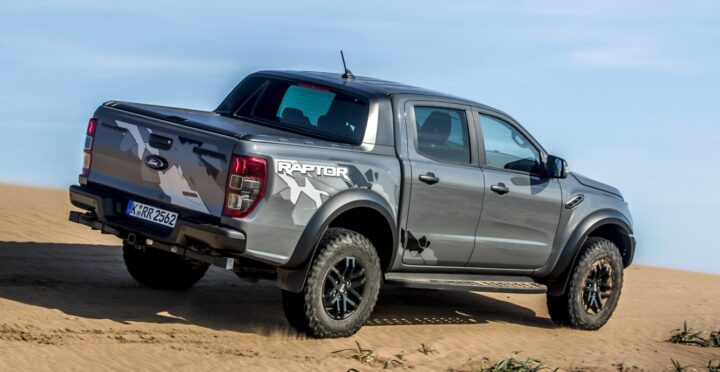
This generation presented the utilization of aluminum for the truck’s body panels dramatically reducing weight and boosting fuel economy. This version of the F-150 is larger than the previous models and features the choice of a base V6, a 2.7-liter, or 3.5-liter Ecoboost turbocharged V6.
2021 – Present Ford F-150 (9th Generation)
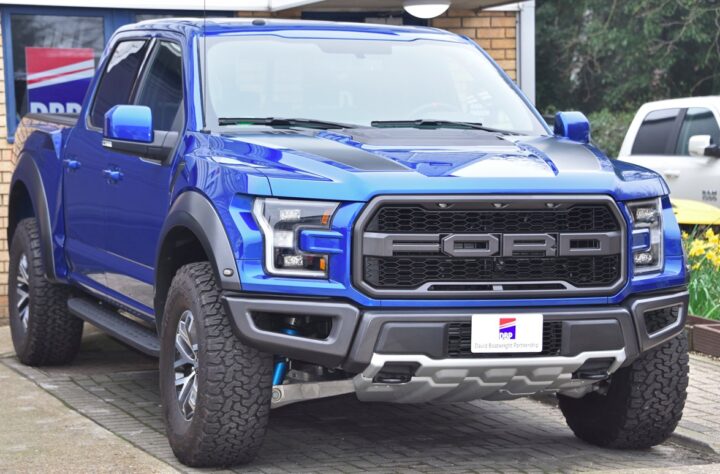
The ninth-generation F-150 was presented in July 2020. Much of what made the previous version so popular has carried over to the present generation: the variety of powertrains, chiseled aluminum body, and several trim levels to suit most needs and budgets.
[socialpoll id=”2768494″]
Ford F-150 Models You Should Avoid Buying
Not all F-150 models have the same reliability. There have been a few bad years for the Ford F-150, in which it was not ideal and has some disappointing specs and horrible reliability. This information was taken from consumereports.org from their recommendations based on customer feedback. So here are the models’ years to avoid while buying a used F-150 without mentioning their issues:
The 2004 Model
Window regulators are the main issue including plastic window clips breaking. It was causing the window to suddenly crash into the door. And it makes a startling noise which causes a distraction for the driver. This is bad for driving and you don’t want to experience this.
The 2005 Model
Its power window regulator fails to continue to plague the 2005 Ford F-150 models. The 5.4L engine tends to knock, which is related to the cam phaser and the bad cylinder heads. Also, spark plug problems remain a central theme with engine problems. The good thing, is these issues are not expensive or overly complicated to fix.
The 2010 Model
Mainly there are complaints related to the Ford touchscreen. These include abrupt screen failure and unresponsiveness. The screen sometimes fails to recognize smartphones devices, and its rear-view camera stops working when the truck is in reverse.
The engine oil pan gasket and the passenger-side head gasket tend to leak. The V6 tends to have a rough idle due to the exhaust recirculation sensors failing. The automatic transmission suddenly downshifts into second gear at times. Again these are issues that can be solved with sensor replacements you can potentially do in your garage instead of spending a paycheck at the dealer.
Reliable And Ideal Ford F-150 Models
On other hand, in some years the F-150 models were ideal and offer great value. So here are the ideal models’ years to buy, with mentioning their top specs.
The 2001 Model
The 2001 model, the new SuperCrew cab allows for a rear-seat place and four full-size doors which offer variety with both the cab and bed sizes. With these bed length options, the wheelbase will also have a variety between 120 and 157.4 inches.
The SuperCrew cab is outfitted like the SUV. It features a power-adjustable accelerator and brake pedals. It also has a luxury leather interior, and rear-seat entertainment system.
In addition to some Improvements to the fuel-efficient engines included with the 4.2L Essex V6, 4.6L Triton V8, 5.4L Triton V8, and the 5.4L Supercharged Triton V8. these engines are highly ranked for their reliability.
The 2009 Model
The redesigning of the New Super Duty style includes a taller hood and larger grille. The six-speed automatic transmission replaced the old four-speed transmission, which made shifting smoother and gave the driver quiet rides. The six-speed also improves the drivability, low-speed acceleration, and fuel efficiency.
The stiff frame and double-wishbone front suspension design Improved the overall handling. Focusing on the safety factors, The 2009 model features full-compartment airbags for improved safety.
The 2018 Model
The streamlined new design of the exterior features a new look for the bumper, lights, and grille.
A great improvement in the fuel economy and shifting ease by adding a new 10-speed automatic transmission and the power stroke diesel adds greater fuel efficiency and towing ability. New safety features have been added including Pre-Collision Assist and Pedestrian Detection.
Reliability indicates how models have performed in the past, providing the basis for predicting how the vehicles will hold up in the year ahead.
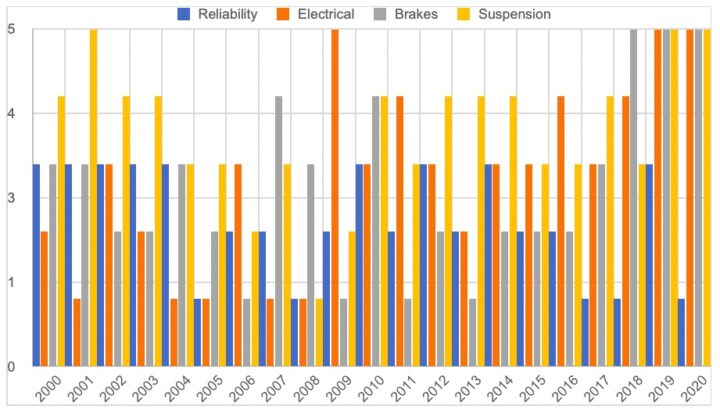
Major F-150 problems
The Engine
You might think the V-6 and V-8 engines in the 2012 model are perfect. Actually, many sources declare 2012 the worst model year because of engine problems. There are about 57 complaints related to the engine for that year’s model. The National Highway Traffic Safety Administration (NHTSA) received an additional 417 complaints.
Consumer Reports reported that this model year got a 2/5 predictive reliability rating, which is higher than every other ensuing model year. So, the people who are interested in the J.D. Power ratings for 2012, which are greater than every other following model year at 88/100, might think the 2012 model year is the one to buy.
The main compliment for the 2012 model engine is the power loss, and it was reported in the 3.5-liter V-6 EcoBoost engines as well as the 5.0-liter V-8, but after taking a look at the actual complaints, most of them is related to the EcoBoost. They often said that the issue is showing up in rainy or humid conditions, with the check engine light coming on followed by a power loss.
However, the NHTSA made a lot of investigations on the 2011 and 2012 models after receiving nearly about 100 complaints about the EcoBoost engine.
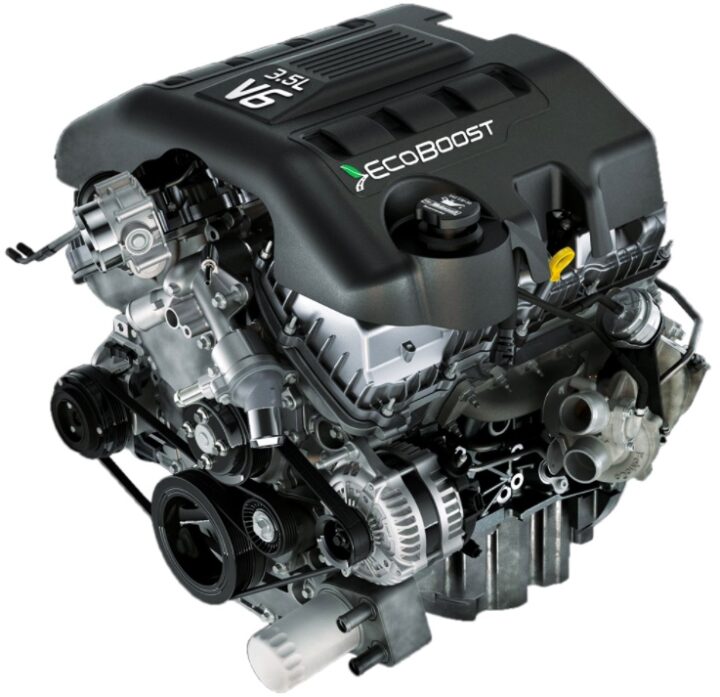
Ford responded by declaring that the charge air cooler can develop condensation, particularly in humid conditions, which can cause a misfire, which leads to the power loss issue. However, Ford said it wasn’t enough to impact drivability, and did issue a technical service bulletin, and told dealers to install a deflector shield to protect the charge air cooler from excessive water in wet conditions.
But what makes us believe this isn’t as big of a deal as you might think is the fact that Consumer Reports doesn’t note this as an issue.
In addition to the 2012 model, CarComplaints.com recorded three other years’ models with obvious engine problems, 2004, 2005, and 2006 models, with 239, 171, and 117 complaints noted, respectively. This is the first three model years of the 11th generation, and the most important two complaints were engine knocking and spark plugs breaking off in the head.
Also, The Consumer Reports recorded the main engine problems in both the 2004 and 2005 models, which lead to rebuild the engine or replace it.
There is also an obvious issue with the throttle bodies on EcoBoost engines. Many owners have stated that the vehicle would enter the limp mode and be forced to drag into the dealer in order to be fixed, which became a common problem.
Window Troubles
Ford F-150 other reliability complaint was that several windows not rolling up. The CarComliments site declared about 650 complaints about 2004 for this issue only. And about 250 other complaints noted for the same issue at the following year.
This looks more annoying, and most of the people reported that replacing the power window regulator is the solution, which costs around $300.
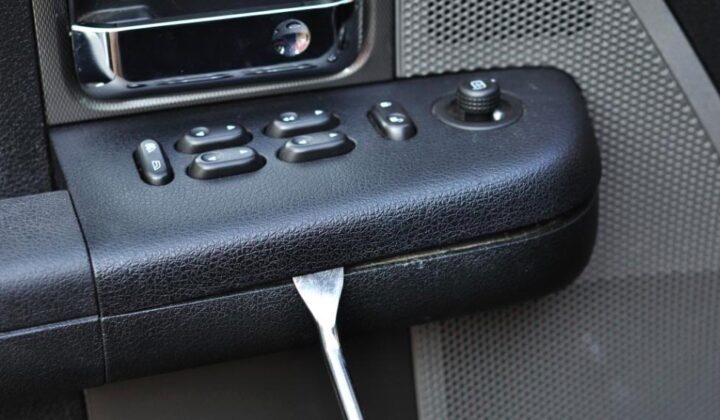
The Consumer Reports site also declares this issue in its hardware body part with a lot of drivers compliment about rear window leaks and window motors not working.
But don’t worry If you’re in the market and found a 16-year-old F-150 because for sure the windows have already failed and have been repaired because the average mileage for failure is about 67K miles.
Transmission Troubles
Ford faced a recall for 1.2 million F-150s in the United States in late 2019. This recall was for F-150 from the 2011 to 2013 years models that were provided with the 6-speed automatic transmission.
The recall stated that the transmission may suddenly downshift into first gear, regardless of the car speed, which results in a sudden loss of car control and increases the accident risks. Furthermore, This recall was besides a 2016 recall of 150K vehicles for the F-150s from the 2011-2012 models years for the same issue.
Now if you moved forward to the 2020 model year, there are claims of other transmission problems with a corresponding lawsuit surrounding the 10-speed automatic transmission. The problem is focused on rough shifts and clanking sounds.
The lawsuit claims stated that the issue is related to the last recall, as the transmission issues were never fully fixed. And there is a transmission recall on the 2017, 2018, and 2020 models, but these recalls are mostly related to the position of the gearshift.
The Consumer Reports website also stated that the transmission issues is one of the most common Ford F-150 reliability issues for 2011, 2012, 2018, and 2019 model years, but it is listed as just a minor issue.
Frozen Door Latches
In March 2017, F-150 owners made a lawsuit and claimed that Ford failed to fix the frozen door latches issue. The automaker had issued about two technical service bulletins, before the lawsuit, but owners stayed reporting issues many years later.
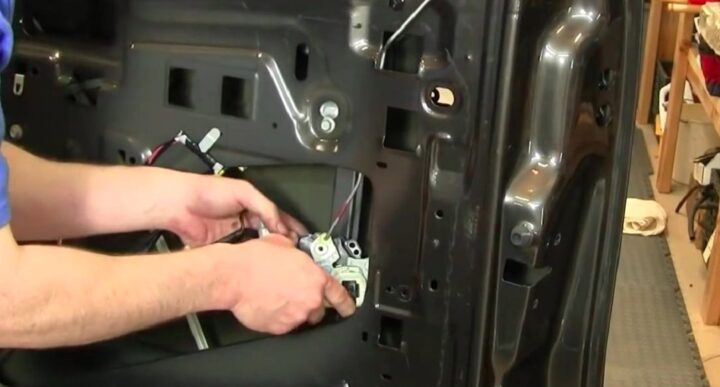
It was only after the lawsuit was made that a recall was issued in April 2017 and applied to the F-150s model years from 2015 to 2017. The real recall was titled “Doors may open while driving”. Once you are getting deep into the recall notes, you will see that the door latches may freeze, which may cause them to suddenly open while driving.
The summary of this long story is the lawsuit was finally settled in March 2020, and if anyone was affected by it before the recall, he is not getting much money as compensation. So, If anyone looking at this model year as a used vehicle, he must make sure that the recall was fixed.
The Bottom Line On Ford F-150 Reliability
Actually, there is no ideal model year for the Ford F-150. But if anyone was going to buy a new or used model, he should focus on the 2014 or 2020 model years and for the end of generation quality and new technology.
A lot of the annoying reliability issues we’ve mentioned are under recall, which means there would be no cost to you to fix. But neither the EcoBoost knock in 2011 and 2012 models nor spark plug breakage issues in 2004 and 2005 models have been addressed via recall, as well their warranty will have been expired for both of these issues.
Thanks for reading and stay dirty

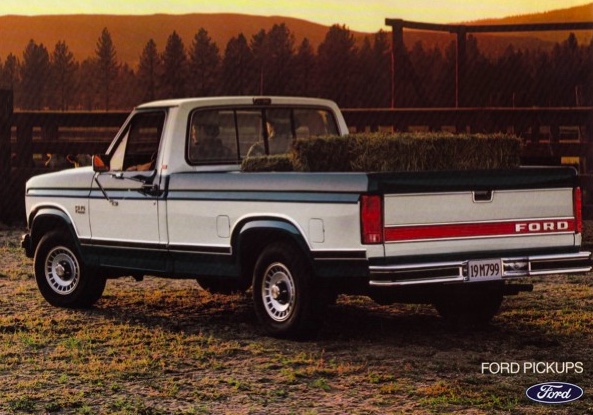
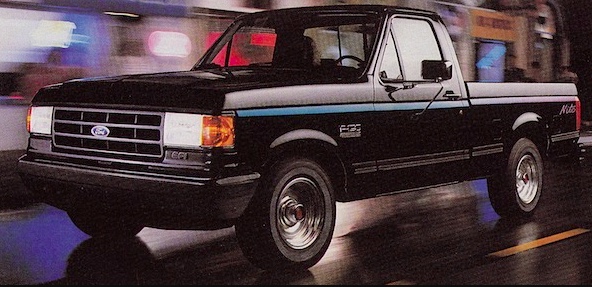
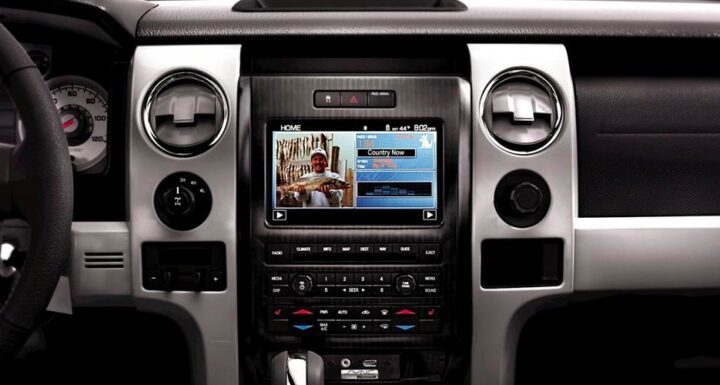
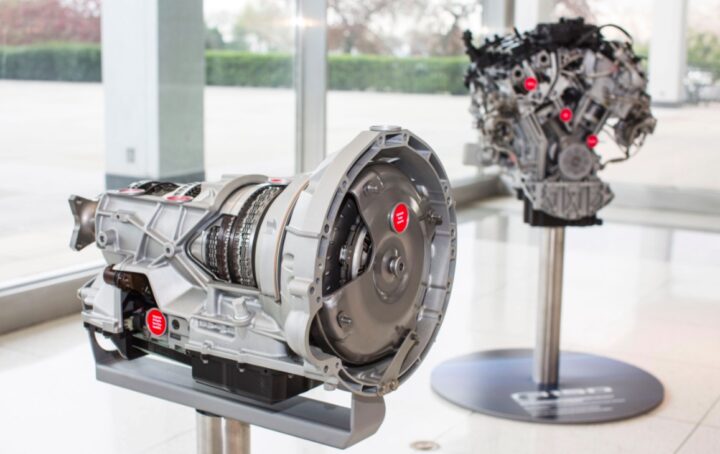
![What is the Dodge RAM 1500 reliability by year? [2022] aventura-cjdr-2019-ram-rebel-off-road](https://149868043.v2.pressablecdn.com/wp-content/uploads/2020/03/aventura-cjdr-2019-ram-rebel-off-road-e1583268162525-300x148.jpg)
![The 16 Most Aggressive All Terrain Tires [2022] reall aggressive all terrain tires on a Jeep](https://149868043.v2.pressablecdn.com/wp-content/uploads/2020/03/slide1-e1585156691843-300x150.jpg)

